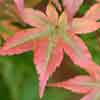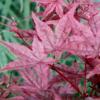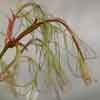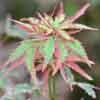| ACER palmatum
'Shigitatsu sawa'
(syn. 'Reticulatum') A good example of the incorrect name being more descriptive than the official one! 'Reticulatum' describes the reticulate pattern of the leaves where the green veins are prominent against silvery or yellow-green interspaces. Shrubby in habit and beautiful, but best to avoid full sun. 1.5-2m See it in our Maple Glade |
||
|
|
||
 |
ACER palmatum
'Shigure bato'
A rare Japanese cultivar from 1930. Red flushed young leaves turn olive green and are incised and deeply divided, almost a dissectum in fact. Gold autumn colour. Expect 2m, so smaller than most of this type. See it in our Maple Glade |
|
|
|
||
 |
ACER palmatum
'Shin chishio'
Previously known as 'Chishio Improved' the name was changed because its previous incarnation did not comply with the "rules" because it contained mixed languages. This is the biggest growing of the group with bright pinky red young growth. We find the colour to be more orange than the others. The colour lasts well through the spring, becoming green in summer. As with all of this group, the intensity of spring colour, and the degree to which it is held through the summer will vary with the light conditions to which it is exposed. More light will result in more intense colour held longer, but watch it doesn't suffer in the summer as a result. 3m |
|
|
|
||
 |
ACER palmatum
'Shin deshojo'
This is one of my favourites with its superb bright pinky red spring colour. Similar to 'Corallinum' and 'Beni Maiko', it is a twiggy shrub with dark purple young stems. Perfect for pot culture or the border. 2m See it in our Maple Glade |
|
|
|
||
 |
ACER palmatum
'Shinobuga oka'
With the typical narrow lobed leaves of the Linearilobum Group, this delightful cultivar forms a sturdy, upright small tree. Bright green summer colour turns to orange-yellow in autumn (see photo right). There are particularly good specimens in the Maple Glade at Westonbirt Arboretum. 2m See it in our Maple Glade |

|
|
|
||
| ACER palmatum
'Shinonome'
No two weeks are seemingly ever the same for this one, with ever-changing colour throughout the season. The show kicks off with orange-red in early spring, changing to deep red, when the leaf veins are accentuated by green tones. Autumn sees the return of the oranges and reds. This well behaved cultivar readily achieves some 3-4m in height with a wonderfully elegant arching habit. See it in our Maple Glade |
||
|
|
||
 |
ACER palmatum
'Shishigashira'
A distinctive form, dense and upright in habit, and distinctly architectural. The small, dark green leaves are heavily curled and set very close together. The predominantly gold and orange autumn colours are some of the very best in the group. It is sometimes found under different names - 'Ribesifolium', 'Crispum' or 'Cristatum'. 1-2m See it in our Quarry Garden |
|
|
|
||
| ACER palmatum
'Shishi
yatsubusa' An elegant yet architectural plant, with small green leaves held horizontally (almost like tiles on a roof). So simple yet so effective. Superb autumn colours. Unfortunately the "Checklist" against which I have meticulously checked my nomenclature deems this one synonymous with 'Mikawa yatsubusa'. Although I could put it in the same "group", for me this is a much more vigorous plant and a much better doer. Similar structure, but definitely not the same. |
||
|
|
||
 |
ACER palmatum 'Shojo-no- mai'
The name translates to “dancing red-face monkey” which somehow fails to do this exquisite plant justice. Very much of the same group as ‘Beni schichihenge’, this one has more intensely pink variegation without the brownish tones of the latter. We are unlikely to propagate this one with any regularity due to the exposed nature of our site. |
|
|
|
||
 |
ACER palmatum
'Shojo'
At first glance another variation on the ubiquitous purple maple. However, it is worth a further look. The young growth is a surprisingly bright red whilst even the basic leaf shape is subtly different and appealing. The strong purple summer colour is held well through the season before developing excellent bright red autumn colours (see picture left). Growth is quite upright when young but it will broaden later in life. I like it very much. 3m See it in our Winter Garden |
|
|
|
||
 |
ACER palmatum
'Sister Ghost'
Thanks again to Talon Buchholz for another of his Flora Wonder introductions. Similar in principle to the well-known 'Shigitatsu sawa', yet even prettier, with more deeply divided leaves. At times a subtle pink blush enhances the more vivid yellow-green spring colour. Some shade during the hottest / brightest part of the day is preferable. Pretty autumn colours too (see picture left). Bushy, arching habit to 2m See it in our Maple Glade |
|
|
|
||
 |
ACER palmatum
'Skeeter's Broom' I have to confess that I'm not wild about most of the witches brooms...but I actually quite like this one! Found in Pennsylvania on 'Bloodgood', it becomes more upright than most of the other similar cultivars. It also has longer leaves than most (usually with the typical truncated central lobe), and for my money is the most purple of them (although it does also exhibit the brighter, more pinky red young growth). It holds its colour well through summer before turning red again in autumn and is pleasingly robust. 2m |
|
|
|
||
 |
ACER palmatum 'Sode nishiki' Simplest described as in the 'Katsura' group, but this one's a bit more subtle. Emerging orange-yellow with pink edging, it matures through deeper orange and red to summer green before bursting into yellow autumn colour. |
|
|
|
||
|
ACER palmatum 'Suminagashi' With its large leaves, this is considered to be one of the best cultivars of its type. The leaves are deeply divided, almost to the base, with the long narrow, well separated lobes elegantly tapering to a point. Each lobe is also toothed. Bright purple red spring colour intensifies to a very deep maroon, before changing through the latter stages of summer to a deep greenish red, finally turning bright red in autumn. Potentially vigorous once established, its semi-upright habit allows it to reach some 6m in time. |
||
|
|
||
|
ACER palmatum 'Summer Gold'
This recent Italian selection is reputed to hold its golden yellow colour much better through even a hot summer, with minimal scorch. However, I have also seen reports that it can suffer significant die back during a wet winter / spring. In my experience that can apply to any maple, but of course the more vigorous trees will be more able to grow through a condition less to its liking. On balance, I think this one has tremendous potential, but it's always important to choose an appropriate site. Its habit is upright initially, broadening with age. Expect 2-3m by half as wide in 10 years. |
||